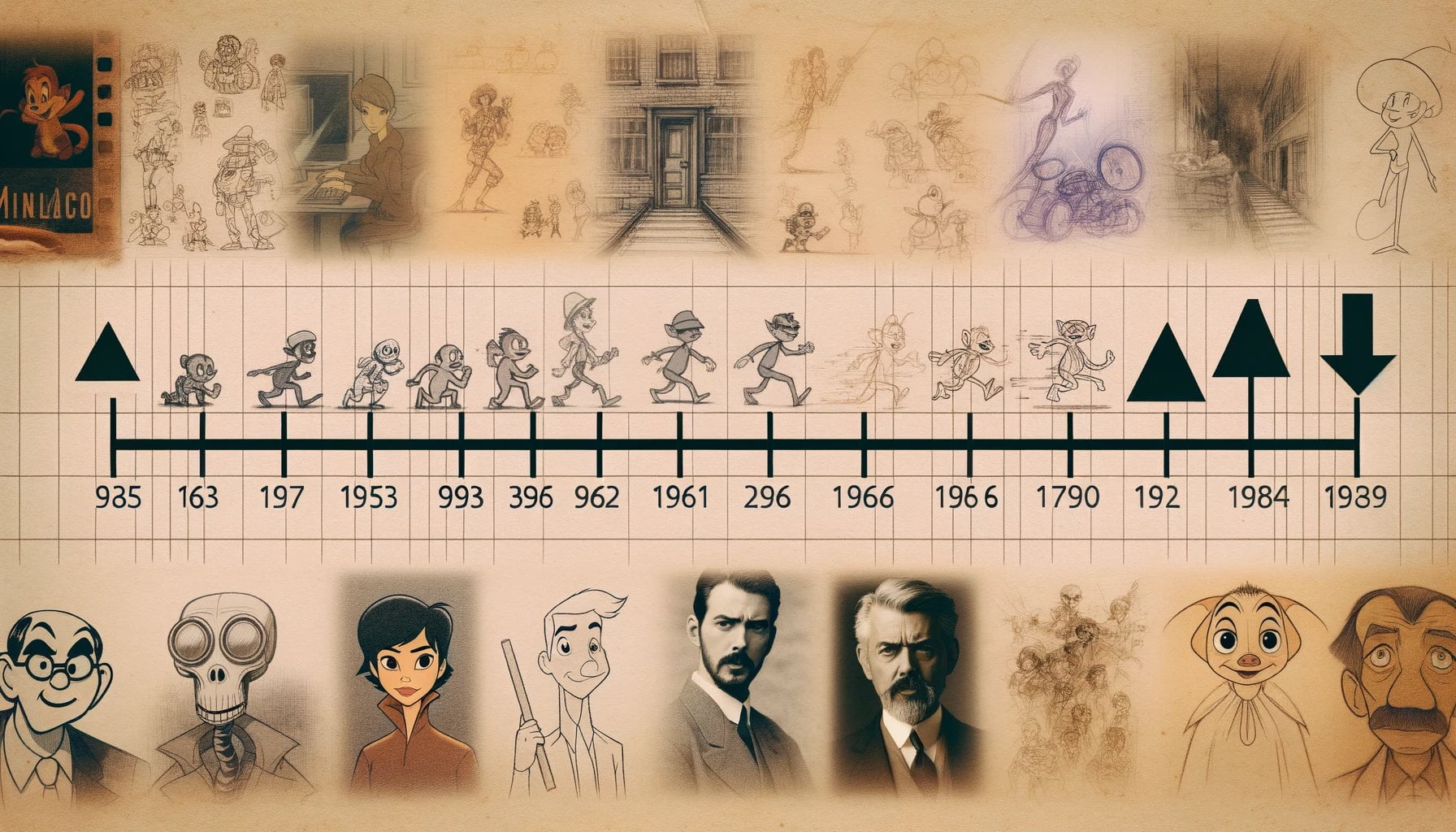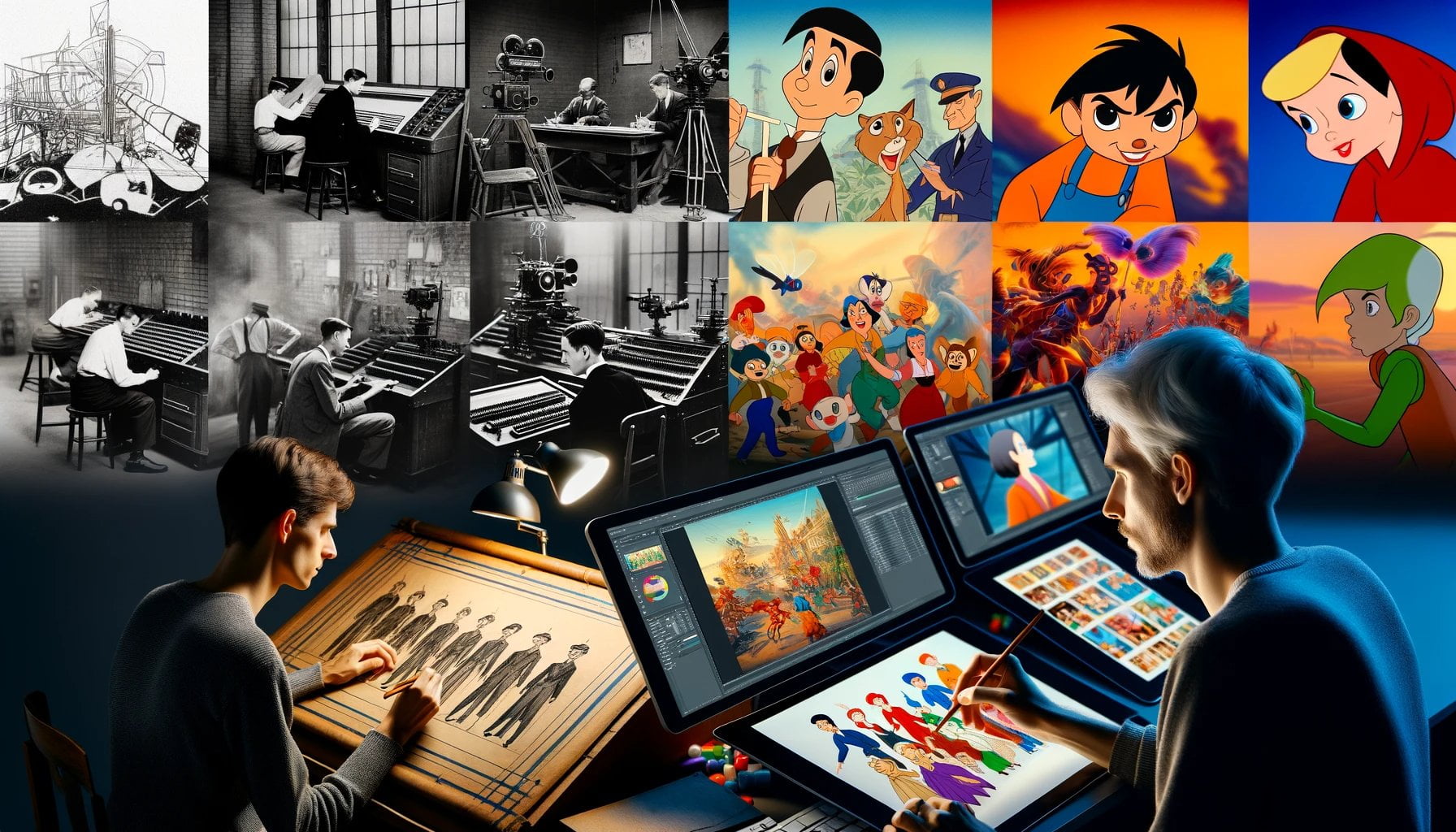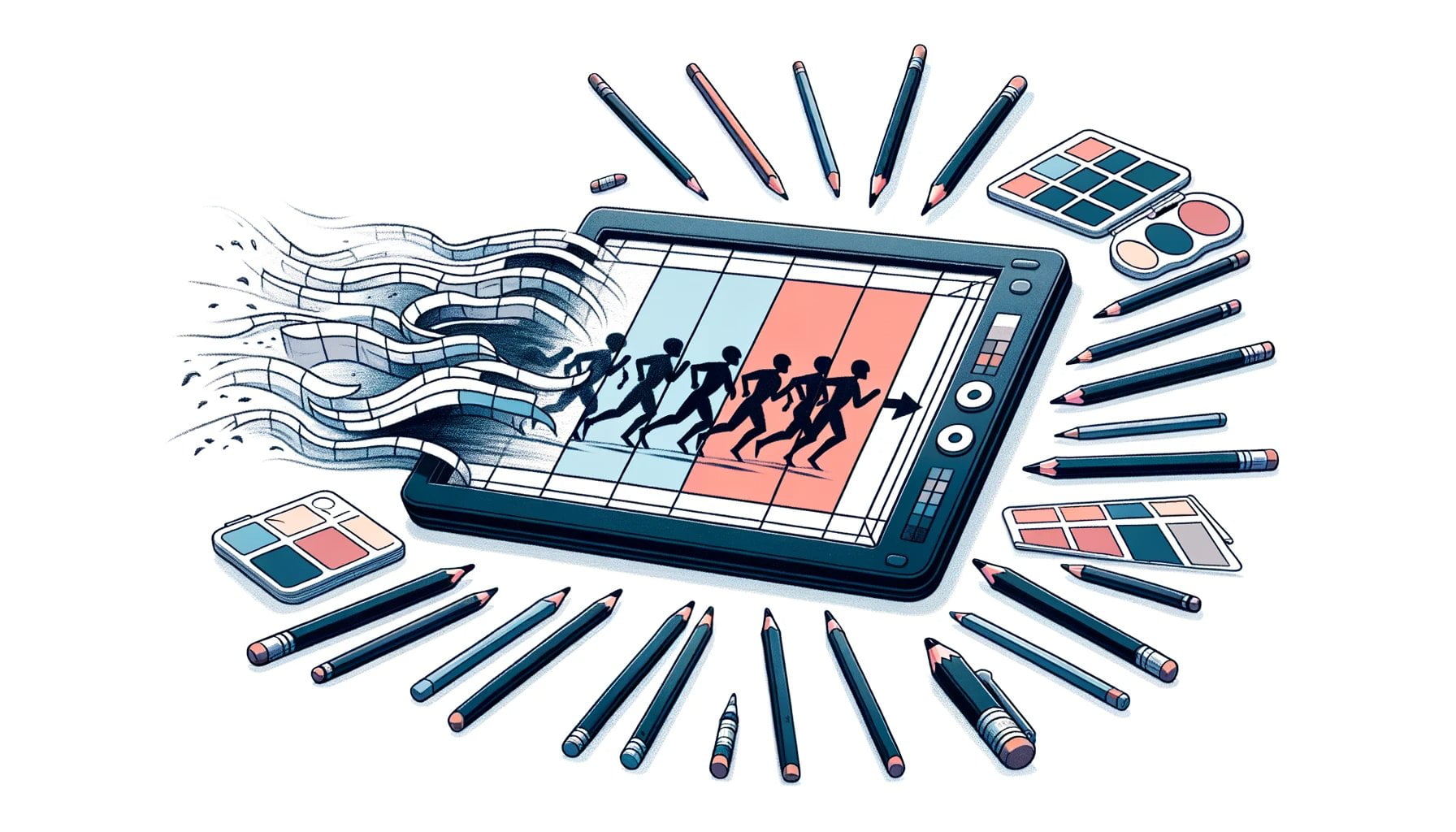Join us on a captivating journey as we unveil the evolution of 2D animation. In this article, we will delve into the rich history of this artistic medium, tracing back its humble beginnings and following its path of transformation through the ages. From the pioneering works of influential animators to the groundbreaking technologies that have pushed the boundaries of imagination, we will explore the milestones that shaped the modern era of 2D animation. Get ready to immerse yourself in a historical adventure that uncovers the secrets and stories behind this beloved art form. Unveiling the Evolution of 2D Animation: A Historical Journey awaits!

Key Takeaways:
- Animation history began with the introduction of celluloid film in 1888.
- Various animation techniques were developed between 1895 and 1920, including stop-motion, puppets, clay or cutouts, and hand-drawn animation.
- Hand-drawn animation on cels became the dominant technique known as traditional animation in the 20th century.
- Computer animation took over as the dominant technique around the early 2000s, but hand-drawn productions like Japanese anime and European animations remain popular.
- Animation has roots in ancient storytelling, visual arts, and theater traditions.
- Pre-film techniques like shadow play, mechanical slides, and mobile projectors in magic lantern shows contributed to the development of animation.
- Modern animation is based on the stroboscopic illusion of motion introduced in 1833.
- The Théâtre Optique, developed by Charles-Émile Reynaud in the 19th century, showcased the first animations on film.
- The 1920s saw the emergence of animations with synchronized sound and the establishment of the Walt Disney Studio.
- Animation played a part in wartime propaganda through public information films in the 1940s.
- Notable individuals mentioned in the article include Jackie Gleason, Peter Sellers, Julie Andrews, Mel Blanc, and Brad Bird.
2D Animation History
The world of animation has come a long way since its humble beginnings. From the earliest techniques of stop-motion and hand-drawn animation to the revolutionary computer-generated imagery (CGI) of today, the evolution of 2D animation is a fascinating journey. In this article, we will delve into the rich history of 2D animation, exploring its origins, key milestones, influential figures, and groundbreaking technologies.
The Early Days: Origins of Animation
The history of animation can be traced back to the emergence of celluloid film in 1888. However, the techniques used in animation existed long before that. Ancient traditions in storytelling, visual arts, and theatre incorporated elements of animated motion, from shadow plays to mechanical slides and mobile projectors in magic lantern shows.
The modern principles of animation took shape in 1833 with the introduction of the stroboscopic illusion of motion. This breakthrough laid the foundation for future advancements in the field. One notable precursor to animation was the Théâtre Optique, developed by Charles-Émile Reynaud in the late 19th century. It featured transparent hand-painted colorful pictures on a long perforated strip, giving rise to the first animations on film.
Traditional Animation Takes the Stage
Between 1895 and 1920, various animation techniques were developed, including stop-motion, puppets, clay or cutouts, and drawn or painted animation. Among these techniques, hand-drawn animation emerged as the dominant form and became known as traditional animation.
Hand-drawn animation, painted on cels, ruled the animation industry for most of the 20th century. Artists painstakingly created each frame, bringing characters and stories to life. This era saw the birth of iconic characters and animation studios, with the founding of the Walt Disney Studio in the 1920s. Disney’s groundbreaking work revolutionized the animation industry and set the stage for future advancements.
Technological Advancements and the Rise of Computer Animation
The turn of the millennium brought about a seismic shift in the animation industry with the widespread adoption of computer animation. CGI allowed animators to create stunning visual effects and realistic 2D characters with ease. From Pixar’s groundbreaking films to DreamWorks’ vibrant creations, computer-generated animation has become the dominant technique in the genre.
However, traditional hand-drawn animation still thrives, particularly in Japanese anime and European productions. These styles have a unique aesthetic and continue to captivate audiences worldwide, showcasing the enduring power of 2D animation.
Key Milestones and Influential Figures
Throughout the history of 2D animation, there have been numerous milestones and influential figures who have shaped the industry. From the introduction of synchronized sound in the 1920s to the use of animation in wartime propaganda films during the 1940s, each era brought its own innovations and challenges.
Notable individuals such as Jackie Gleason, Peter Sellers, Julie Andrews, Mel Blanc, and Brad Bird have contributed to the evolution of 2D animation through their talent and creativity. Their work has left an indelible mark on the industry and inspired future generations of animators.
Conclusion: A Dynamic Journey
The evolution of 2D animation is a dynamic journey that spans over a century. From its origins in ancient traditions to the advancements of modern technology, this art form has continually pushed boundaries and captivated audiences. Whether it be the intricate hand-drawn animation of traditional techniques or the dazzling CGI of computer animation, the history of 2D animation is a testament to the power of creativity and imagination.
So, next time you watch your favorite animated film, take a moment to appreciate the rich history and the many talented individuals who have contributed to the vibrant world of 2D animation.
| Year | Event |
|---|---|
| 1888 | Emergence of celluloid film. |
| 1833 | Introduction of stroboscopic illusion of motion. |
| Late 19th century | Development of the Théâtre Optique with hand-painted colorful pictures. |
| 1920s | Development of animations with synchronized sound and the founding of the Walt Disney Studio. |
| 1940s | Use of animation in wartime propaganda films. |
In the world of animation, understanding its rich history is crucial. Explore the fascinating journey of animation through time by delving into its captivating history. Discover the evolution, milestones, and innovations that have shaped this mesmerizing art form. Dive deep into the depths of animation history here.
Influential Figures in the History of 2D Animation
J. Stuart Blackton: Pioneering Stop-Motion Animation
J. Stuart Blackton, co-founder of Vitagraph Studios, was an influential figure in the early days of 2D animation. His film, “The Humpty Dumpty Circus” (1898), showcased his innovative use of the stop-motion technique, bringing inanimate objects to life through meticulous frame-by-frame manipulation.
Émile Reynaud: Early Animation Innovator
Émile Reynaud, a French artist, played a significant role in the history of 2D animation with his invention of the Praxinoscope in the late 19th century. This device was an early example of animation, using a rotating drum with mirrors to create the illusion of movement.
William Horner: Zoetrope and the Birth of Animation
In 1834, William Horner created the Zoetrope, a precursor to modern animation. This cylindrical device displayed a series of images on the inside, producing the illusion of motion when spun. Horner’s innovative creation laid the foundation for the development of 2D animation techniques.
Émile Cohl: The Father of Animated Film
Émile Cohl, a French artist, holds the distinction of creating the first-ever animated film, “Fantasmagorie,” in 1908. His experimental approach to animation, using hand-drawn techniques, paved the way for future animators and established him as a pioneer in the field.
Walt Disney: Revolutionizing Animation with “Snow White and the Seven Dwarfs”
No discussion of influential figures in 2D animation would be complete without mentioning Walt Disney. His studio’s groundbreaking film, “Snow White and the Seven Dwarfs” (1937), marked the first animated feature film using the traditional cel animation process. Disney’s dedication to storytelling and innovative techniques transformed animation into a respected art form.
Winsor McCay: Master of Hand-Drawn Animation
Winsor McCay, an American cartoonist and animator, was another key figure in the history of 2D animation. He experimented with hand-drawn techniques, stunning audiences with his imaginative and detailed animations. McCay’s work, including the iconic film “Gertie the Dinosaur” (1914), showcased his unparalleled skill and influence in the industry.
Key Takeaways:
- J. Stuart Blackton pioneered stop-motion animation with “The Humpty Dumpty Circus.”
- Émile Reynaud’s Praxinoscope contributed to the early development of 2D animation.
- William Horner’s Zoetrope laid the foundation for animation techniques.
- Émile Cohl created the first-ever animated film, “Fantasmagorie.”
- Walt Disney revolutionized animation with “Snow White and the Seven Dwarfs.”
- Winsor McCay excelled in hand-drawn animation, influencing the industry with his work.
With these influential figures as pillars of the 2D animation industry, their contributions have shaped the evolution of this art form and continue to inspire contemporary animators. By understanding their techniques and embracing their creativity, we can move forward while honoring the rich history of 2D animation.
Technological Advancements in 2D Animation
The history of 2D animation is intertwined with technological advancements that have revolutionized the industry, pushing the boundaries of creativity and storytelling. From its humble beginnings in the late 1800s to the modern era, various advancements have shaped the evolution of 2D animation, making it the vibrant art form it is today.
The Early Years: From Hand-Drawn to Zoetropes
In the late 1800s, the origins of 2D animation can be traced back to hand-drawn animations using stop-motion techniques. Films like “Sword in the Stone” by Disney were among the first 2D animated films, setting the stage for the industry’s development.
Key Takeaways:
– Hand-drawn animations created using stop-motion techniques marked the beginning of 2D animation.
– “Sword in the Stone” by Disney was one of the first 2D animated films.
Technological Leaps: From Flipbooks to Computers
Technological advancements have been at the forefront of 2D animation’s evolution. Innovations like the phenakistoscope disks, flipbooks, and the zoetrope pushed the boundaries of what was possible, allowing animators to bring their creations to life.
Key Takeaways:
– Phenakistoscope disks, flipbooks, and zoetropes propelled the evolution of 2D animation.
– These inventions allowed animators to create the illusion of motion on a flat surface.
The Digital Era: Computers and Beyond
The introduction of computers marked a turning point in the 2D animation industry. Technologies like augmented reality (AR) and virtual reality (VR) opened up new possibilities for animation, enabling artists to blend the physical and digital worlds seamlessly. The growth of digital content creation has further expanded the horizons of 2D animation, providing new tools and techniques for artists to explore.
Key Takeaways:
– Computers brought transformative shifts in the 2D animation landscape.
– Augmented reality (AR) and virtual reality (VR) technologies have expanded the possibilities of 2D animation.
– Digital content creation has provided new tools and techniques for artists to experiment with.
The Popularity and Future of 2D Animation
While 3D animation has gained prominence worldwide, 2D animation remains popular and innovative, particularly in Japan. It offers a unique artistic style and a distinct way of storytelling that cannot be replicated in 3D. The future of 2D animation looks promising, with ongoing advancements in technology and continued growth in the industry.
Key Takeaways:
– 2D animation continues to thrive, especially in Japan.
– The future of 2D animation is bright, with advancements in technology and increasing opportunities.
Key Takeaways:
- Hand-drawn animations using stop-motion techniques marked the beginning of 2D animation.
- “Sword in the Stone” by Disney was one of the earliest 2D animated films.
- Technological advancements like phenakistoscope disks, flipbooks, and zoetropes drove the evolution of 2D animation.
- Computers brought transformative shifts in the 2D animation industry, enabling the blend of physical and digital worlds.
- Augmented reality (AR), virtual reality (VR), and digital content creation have expanded the possibilities for 2D animation.
- 2D animation remains popular and innovative, particularly in Japan.
- The future of 2D animation is promising, with ongoing advancements in technology and industry growth.
The impact of 2D animation on the modern era
2D animation has had a profound impact on the modern era, shaping the way we tell stories, communicate ideas, and entertain audiences. From its humble beginnings to the present day, 2D animation has continuously evolved, adapting to new technologies and pushing creative boundaries.
A Journey Through Time
Let’s take a journey through the history of 2D animation and explore its enduring influence.
Origins and Innovations
The roots of animation can be traced back to ancient traditions of storytelling and visual arts. However, it was in the late 19th century that the modern principles of animation began to take shape. Innovations like the stroboscopic illusion of motion and the Théâtre Optique paved the way for the first animated films.
Traditional Animation
Hand-drawn animation, also known as traditional animation, dominated the industry for most of the 20th century. Visionaries like Walt Disney revolutionized the art form with films like “Snow White and the Seven Dwarfs,” captivating audiences with magical stories and memorable characters.
Technological Advancements
The turn of the millennium brought about a significant shift in 2D animation with the widespread adoption of computer animation. This allowed for stunning visual effects and the creation of realistic 2D characters. Technological advancements like augmented reality (AR), virtual reality (VR), and digital content creation further expanded the possibilities for 2D animation.
Enduring Popularity
Despite the rise of 3D and CGI animation, 2D animation remains popular and innovative, especially in countries like Japan. Its distinct style and ability to evoke emotion through expressive storytelling continue to captivate audiences around the world.
The Influence of 2D Animation
Now that we’ve explored the evolution of 2D animation, let’s delve into its impact on the modern era.
Visual Communication at its Finest
2D animation is a powerful tool for visual communication. Its ability to bring inanimate objects to life and capture the imagination of viewers makes it highly effective in conveying complex ideas and concepts. Compared to static images, animations attract more attention and leave a lasting impression.
Inspiring Creativity and Imagination
2D animation has inspired countless artists and storytellers, pushing the boundaries of what is possible. Through the skillful use of motion, color, and character design, animators can create worlds that ignite the imagination and transport audiences to new realms of wonder.
Breakthroughs in Technology
The impact of 2D animation on the modern era cannot be overstated in terms of technological advancements. From the introduction of computers to the integration of physical and digital worlds, technology has played a pivotal role in shaping the way animations are created and consumed. The possibilities for innovation and artistic expression are endless.
Entertainment and Education
2D animation has a dual role in both entertainment and education. It has the power to entertain and captivate audiences of all ages, transporting them to different worlds and telling compelling stories. Furthermore, 2D animation can be utilized as an educational tool, simplifying complex topics and making them more accessible to learners.
Key Takeaways:
- 2D animation has a rich history that dates back to the late 19th century, with technological advancements and storytelling innovations shaping its evolution.
- Despite the rise of 3D and CGI animation, 2D animation remains popular and influential, particularly in countries like Japan.
- The impact of 2D animation is seen in its ability to visually communicate ideas, inspire creativity and imagination, drive technological advancements, and entertain and educate audiences.
- Through the skillful use of motion, color, and character design, 2D animation creates immersive worlds that captivate viewers and leave a lasting impression.

FAQs
Q1: When did the history of 2D animation begin?
A1: The history of animation began after the emergence of celluloid film in 1888.
Q2: What were some of the early animation techniques developed in the late 19th and early 20th century?
A2: Between 1895 and 1920, various animation techniques were developed, including stop-motion, puppets, clay or cutouts, and drawn or painted animation.
Q3: Who is credited with creating the first-ever animated film?
A3: French artist Émile Cohl is credited with creating the first ever animated film, Fantasmagorie, in 1908.
Q4: What was the first animated feature film produced using traditional animation techniques?
A4: Walt Disney Studios’ Snow White and the Seven Dwarfs (1937) was the first animated feature film, using the traditional animation process of cel animation.
Q5: How has technology influenced the evolution of 2D animation?
A5: Technology has played a crucial role in the evolution of animation. From the early ages of phenakistoscope disks and flipbooks to the invention of the zoetrope, technology has helped animation evolve from 2D to 3D and even stereoscopic 3D.
















